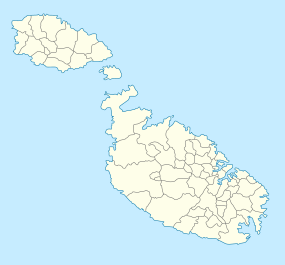Għar Dalam

Entering the cave of Għar Dalam
|
|
| Location | Birżebbuġa, Malta |
|---|---|
| Coordinates | 35°50′11.1″N 14°31′40.9″E / 35.836417°N 14.528028°ECoordinates: 35°50′11.1″N 14°31′40.9″E / 35.836417°N 14.528028°E |
| Type | Cave |
| Length | 144m |
| History | |
| Material | Limestone |
| Founded | c. 5200 BC |
| Periods | Għar Dalam phase |
| Site notes | |
| Ownership | Government of Malta |
| Management | Heritage Malta |
| Public access | Yes |
| Website | Heritage Malta |
Għar Dalam ("Cave of Darkness", IPA: [aːr 'dalam]) is a prehistorical cul-de-sac (a cave with only one entrance) located in the outskirts of Birżebbuġa, Malta, containing the bone remains of animals that were stranded and subsequently became extinct in Malta at the end of the Last Glacial Maximum. It has lent its name to the Għar Dalam phase in Maltese prehistory.
Dwarf elephant, hippopotamus, deer and bear bone deposits found there are of different ages; the hippopotamuses became extinct about 10,000 years ago, whilst the deer species became extinct much later, about 4000 years ago during the Chalcolithic. It is also here that the earliest evidence of human settlement on Malta, some 7400 years ago, was discovered.
The cave was first scientifically investigated in 1885. It was included on the Antiquities List of 1925, but was not opened to the public until 1933. It was used as an air-raid shelter during World War II. A museum was set up on site by the then-Curator of Natural History, Joseph Baldacchino. In 1980, the most important and irreplaceable relics—such as four tusks of dwarf elephants and the skull of a Neolithic child—were stolen from the museum.
The cave was investigated in 1987 under the direction of Emmanuel Anati, professor of paleontology at the University of Salento. His team of Italian archaeologists from the Centro Camuno di Studi Preistorici discovered Palaeolithic cave art depicting human hands, anthropozoomorphic, and several animal designs from underneath the stalagmatic formations. Some depict elephants which have been extinct in the Maltese region since the . Most of these finds were destroyed due to recent vandalism.
...
Wikipedia

